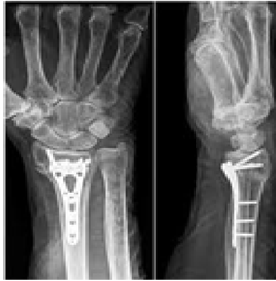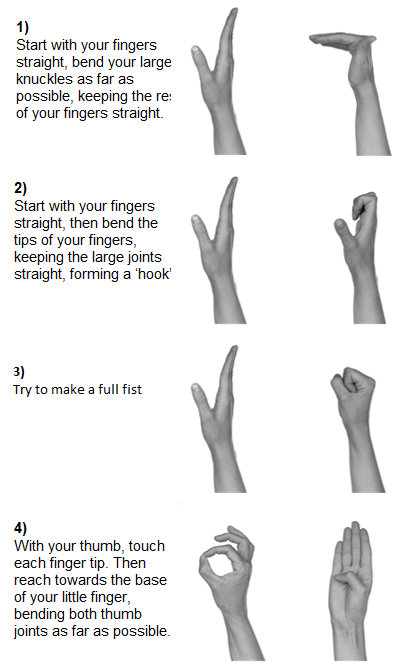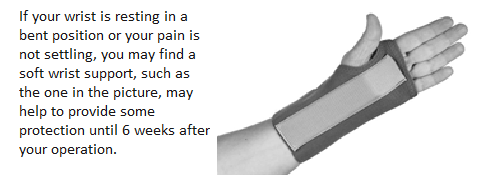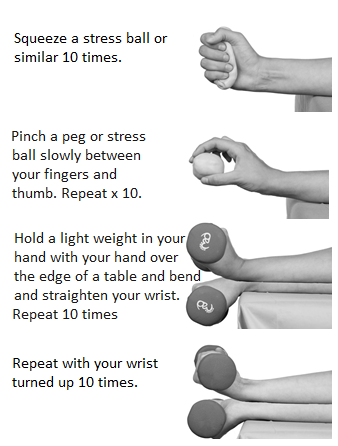Open reduction internal fixation (ORIF)
To view this as a pdf; click here.
What is an ORIF (Open Reduction Internal Fixation)?
If a wrist is broken in such a way that the ends of the fracture do not meet in the correct position, or cannot be held in the correct position, an operation may be required to insert fixation devices (such as screws, wires or plates). The aim of these devices is to hold your fracture stable so that you can start to move your wrist more quickly than if you were in plaster of paris (POP), and prevent stiffness associated with immobilisation.

Immediately after your operation:
You will return from theatre with your wrist heavily bandaged. You may not be able to feel or move your hand, due to the anaesthetic block. The block may remain active for 12-8 hours.
It is important to rest and elevate the wrist as much as possible to prevent further swelling. Rest with your arm elevated, preferably above the level of your heart. You may be given a sling to help with this. If so make sure you take your arm out of the sling regularly to move your shoulder and elbow to prevent them stiffening. Also remove when you go to bed.
You may be asked to remove the outer layers of bandages after a few days (crepe bandage and wool). There will be a plaster type dressing directly over the wound. Keep this in place for 10-14 days.
As soon as you are able to, start gently moving your hand and wrist to prevent stiffness, move into discomfort but not pain. Try the exercises below.


Repeat each exercise x10 and the whole sequence 4 times a day, preferably after painkillers, if you are taking any.
A follow-up appointment will be arranged for you, to be reviewed by a Physiotherapist 10-14 days following your operation.
2 weeks after your operation:
You can remove the dressing from your wrist. If it is healed, you can start to massage your scar with non scented moisturiser. You should apply moderate pressure and massage in a circular motion directly over your scar. Continue for around 5 minutes 4 times a day.
You should try to use your hand for light activities, lifting no more than 1kg in weight. Do not attempt any heavy lifting, hard gripping or applying weight through your hand for 3 months following your operation. Driving can be considered from 6 weeks following your operation.

6 weeks after your operation:
It is important that you start to wean yourself out of the soft support if you have one. Steadily build up the use of your hand, and progress to more demanding functional activities. It may be some weeks before full strength returns and you should continue to avoid heavy lifting, hard gripping or applying weight through your hand until 3 months after your operation.
You can consider driving at 6 weeks following your operation, only if you feel safe and confident. It may be worth checking with your insurance company.
Try the following exercises to increase your movement and strength. Accept discomfort but not pain with your exercises. You may still need pain relief to perform your exercises. Complete the whole routine 4 times daily.


3 months after your operation:
An appointment may be arranged for you to be seen again in the clinic by the doctor. This will give you the chance to discuss any concerns you may have with the doctor. You may have an X-ray to check the healing and may be discharge from the clinic.
At 3 months, your fracture should be healed well, and you may progress to your full level of function, including heavy lifting, hard gripping and weight bearing on your arm.
If you have any queries regarding your exercises please contact the Physio direct service on 01792 487453 (Monday to Friday 9:00am-10:00am)
Please note: We are in the process of updating our website. The Welsh language is important to us and we are currently translating our content. Thank you for your patience. Ry'n ni'n y broses o ddiweddaru ein gwefan. Mae'r Gymraeg yn bwysig i ni ac ry'n ni wrthi ar hyn o bryd yn cyfieithu ein cynnwys. Diolch i chi am fod yn amyneddgar.
Rydym yn croesawu gohebiaeth a galwadau ffôn yn y Gymraeg neu'r Saesneg. Atebir gohebiaeth Gymraeg yn y Gymraeg, ac ni fydd hyn yn arwain at oedi. Mae’r dudalen hon ar gael yn Gymraeg drwy bwyso’r botwm ar y dde ar frig y dudalen.
We welcome correspondence and telephone calls in Welsh or English. Welsh language correspondence will be replied to in Welsh, and this will not lead to a delay. This page is available in Welsh by clicking ‘Cymraeg’ at the top right of this page.